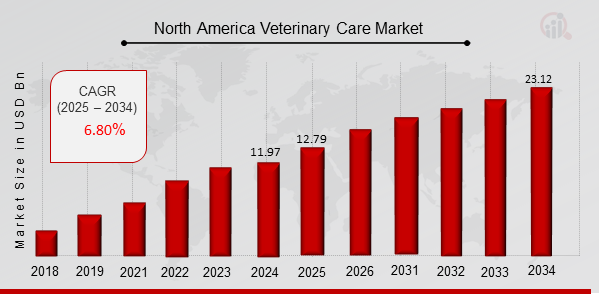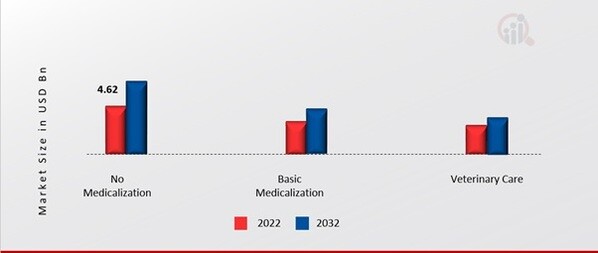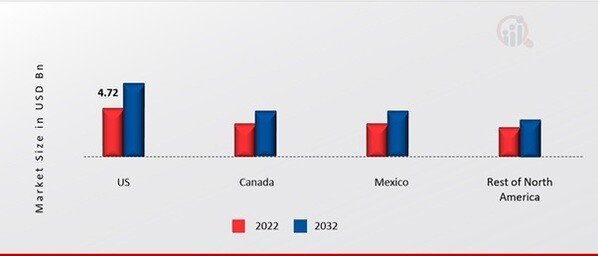North America Veterinary Care Market Overview
As per MRFR analysis, the North America Veterinary Care Market Size was estimated at 11.97 (USD Billion) in 2024. The North America Veterinary Care Market Industry is expected to grow from 12.79 (USD Billion) in 2025 to 23.12 (USD Billion) till 2034, at a CAGR (growth rate) is expected to be around 6.80% during the forecast period (2025 - 2034). The growing perception of pets as family members is one of the major drivers driving the veterinary care market in North America. Industries are adopting Veterinary Care due to advancements in treatments and diagnostics.

Source: Secondary Research, Primary Research, MRFR Database and Analyst Review
Veterinary Care Market Trends
- Growing adoption of telemedicine in veterinary care is driving the market growth.
The North American Veterinary Care market CAGR is expanding due to the adoption of telemedicine in veterinary care. It allows pet owners to connect with veterinarians remotely, seeking advice on non-emergency issues, discussing symptoms, and receiving guidance on basic healthcare. This trend has gained traction, especially with the advancements in digital communication technologies and the increased acceptance of virtual interactions. Telemedicine offers convenience for pet owners and helps address concerns promptly, reducing the need for physical visits unless absolutely necessary. This trend has become even more prominent after the COVID-19 pandemic, where remote services gained prominence to ensure safety and adhere to social distancing measures.
Furthermore, the growth of the Veterinary Care market is influenced by a growing emphasis on preventive healthcare in North America. Pet owners increasingly recognize the importance of preventive measures to ensure their animals' well-being and avoid costly treatments for advanced illnesses. This shift in mindset has led to a raised demand for wellness exams, vaccinations, and preventive treatments. Veterinary clinics are responding by offering comprehensive preventive care packages, including regular check-ups, vaccinations, dental care, and nutritional counseling. This proactive approach benefits the health of pets and contributes to the long-term sustainability of the veterinary care market by reducing the burden of treating advanced diseases. Thus driving the Veterinary Care market revenue.
Veterinary Care Market Segment Insights
Veterinary Care Animal Type Insights
The North America Veterinary Care market segmentation, based on animal type, includes Dogs, Cats, Cattle, Pigs, Horses, and Poultry. The dogs segment dominated the market. With a focus on canine health, veterinary care services cater to the diverse needs of dog owners. This specialized segment addresses preventive care, medical treatments, and overall dog well-being, reflecting the region's commitment to providing comprehensive and specialized veterinary services for this popular pet species.
Veterinary Care Treatment Type Insights
The North America Veterinary Care market segmentation, based on treatment type, includes No Medicalization, Basic Medicalization, and Veterinary Care. The no medicalization category generated the most income. It signifies approaches in veterinary care that do not involve traditional medical interventions. It may include holistic or alternative therapies, preventive measures, or animal lifestyle adjustments, emphasizing non-medicalized strategies to maintain or enhance their well-being. This segment reflects a growing awareness and acceptance of non-conventional methods in veterinary care within the North American market.
Figure 1: North America Veterinary Care Market, by Medicalization Type, 2022 & 2032 (USD Billion)

Source: Secondary Research, Primary Research, MRFR Database and Analyst Review
Veterinary Care Country Insights
The rapid expansion of the advancements in diagnostics has resulted in a boom in demand for Veterinary Care in North America in recent years. In the United States, the largest market in the region, the rising pet ownership and increasing awareness about animal health drive the demand for veterinary services. Advanced medical technologies, diagnostic tools, and therapeutic options contribute to the market's expansion. Canada exhibits a similar trend, with a growing emphasis on preventive care and pet wellness. Both countries witness a surge in pet insurance adoption, fostering comprehensive healthcare. While evolving, Mexico experiences a rising pet population and a gradual shift towards specialized veterinary services. The North American veterinary care market reflects a dynamic landscape shaped by evolving pet care preferences and advancing medical capabilities.
Figure 2: NORTH AMERICA Veterinary Care MARKET SHARE BY REGION 2022 (USD Billion)

Source: Secondary Research, Primary Research, MRFR Database and Analyst Review
Veterinary Care Key Market Players & Competitive Insights
Leading market players are investing majorly in research and development to spread their product lines, which will help the Veterinary Care market grow even more. The participants also undertake various strategic activities to spread their footprint with new market developments, including product launches, contractual agreements, mergers and acquisitions, major investments, and collaboration with other organizations. The Veterinary Care industry must offer cost-effective items to spread and survive in a competitive and rising market climate.
Major players in the Veterinary Care market are attempting to raise market demand by investing in research and development operations includes Zoetis (US), Merck (US), Boehringer Ingelheim (Germany), Elanco (US), Ceva (France), Phibro Animal Health Corporation (US), Virbac SA (France), IDEXX Laboratories, Inc. (US), Neogen Corporation (US), Heska Corporation. (US).
Key Companies in the Veterinary Care market include
- Boehringer Ingelheim (Germany)
- Phibro Animal Health Corporation (US)
- IDEXX Laboratories, Inc. (US)
Veterinary Care Industry Developments
February 2020: Zoetis acquired Ethos Diagnostic Science. It will expand the company's product portfolio and help it grow exponentially in the veterinary space.
Veterinary Care Market Segmentation
Veterinary Care Animal Type Outlook
Veterinary Care Medicalization Type Outlook
Veterinary Care Regional Outlook
| Report Attribute/Metric |
Details |
|
Market Size 2024
|
11.97 (USD Billion)
|
|
Market Size 2025
|
12.79 (USD Billion)
|
|
Market Size 2034
|
23.12 (USD Billion)
|
|
Compound Annual Growth Rate (CAGR)
|
6.80 % (2025 - 2034)
|
|
Report Coverage
|
Revenue Forecast, Competitive Landscape, Growth Factors, and Trends
|
|
Base Year
|
2024
|
|
Market Forecast Period
|
2025 - 2034
|
|
Historical Data
|
2020 - 2024
|
| Report Coverage |
Revenue Forecast, Market Competitive Landscape, Growth Factors, and Trends |
| Segments Covered |
Animal Type, Medicalization Type, and Region |
| Region Covered |
North America |
| Countries Covered |
The US, Canada, Mexico, and the Rest of North America |
| Key Companies Profiled |
Zoetis (US), Merck (US), Boehringer Ingelheim (Germany), Elanco (US), Ceva (France), Phibro Animal Health Corporation (US), Virbac SA (France), IDEXX Laboratories, Inc. (US), Neogen Corporation (US), and Heska Corporation. (US) |
| Key Market Opportunities |
· Growing awareness of the role of preventive healthcare for pets |
| Key Market Dynamics |
· Growing trend of considering pets as family members · Increasing adoption of pet insurance |
Frequently Asked Questions (FAQ) :
The North America Veterinary Care market was valued at USD 10.5 Billion in 2022.
The market is projected to grow at a CAGR of 6.80% during the forecast period, 2025-2034.
The key players in the market are Zoetis (US), Merck (US), Boehringer Ingelheim (Germany), Elanco (US), Ceva (France), Phibro Animal Health Corporation (US), Virbac SA (France), IDEXX Laboratories, Inc. (US), Neogen Corporation (US), and Heska Corporation. (US).
The dogs category dominated the market in 2022.
The no-medicalization category had the largest share of the market.

















